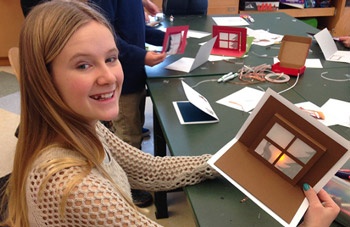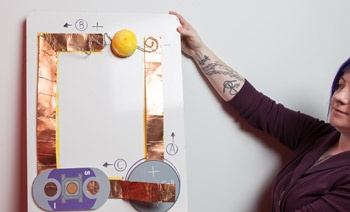Electronic craft projects are quickly becoming one of our most popular activities for classrooms exploring STEAM. Students can learn about simple circuits through building creative pop-up cards with copper tape, LEDs,
 Over the past few years, the SparkFun Education team has taught paper circuit pop-up card activities at workshops,
Over the past few years, the SparkFun Education team has taught paper circuit pop-up card activities at workshops,
Taking cues from the success of the giant soldering and breadboard props we used at large events such as our Autonomous Vehicle Competition (AVC) and various Maker Faires, we created some oversized paper circuit demos to help us instruct.

We’ve had a few different iterations of these paper circuit teaching tools over the years. The first was a custom-printed template based on our downloadable circuit templates and laminated on foam board. As we taught the lesson, we used 2-inch copper tape and stuck it directly to the large template.
To minimize cost and waste of materials as we expanded our class and template offerings, we switched to hand-drawn versions of the diagrams and copper tape strips backed with velcro for reuse.
If you’d like to try making your own instructional props for paper circuits in the classroom or maker events, here are some of the materials and techniques we use.

For LED props, you will need:
- Styrofoam ball

- Paint
- Pipe cleaners
- Velcro
These oversized LEDs help us demonstrate how to bend the legs of
For battery and button props, you will need:
 Printer (or markers)
Printer (or markers)- Cardstock
- Lamination sheets (to add durability to printed components)
- Velcro
Print (or draw) an oversized version of any flat components needed in the circuit. You can also photograph components and print them out. Make sure to include any part labels or information as needed. Laminate and attach a tab of velcro to the back. We’ve created some simplified illustrations that are easier to teach with than photographs. Download printable PDF versions here: LilyPad Button Board and Coin Cell Battery.
To make the base template:
- Large foam board or dry-erase board (we use 18"x24" or 24"x36" depending on the scale of the audience and need for portability)
- Permanent marker and ruler to draw template

- 2" Copper Tape
- Cardstock
- Velcro
Using a ruler and permanent marker, draw the template onto a board, translating all important labels and info to the drawing. We fill in the lines where
Cut strips of copper tape in lengths needed for each part of the circuit, remove paper backing and stick to scrap paper or cardstock. Add velcro tabs
Paper Circuit Project Tutorials
Ready to start making some paper circuit projects with your students? Check out our tutorials for full project instructions and downloadable templates.
What's your favorite tip for showing large groups small details?



paper circuits, teaching tools, Maker Education